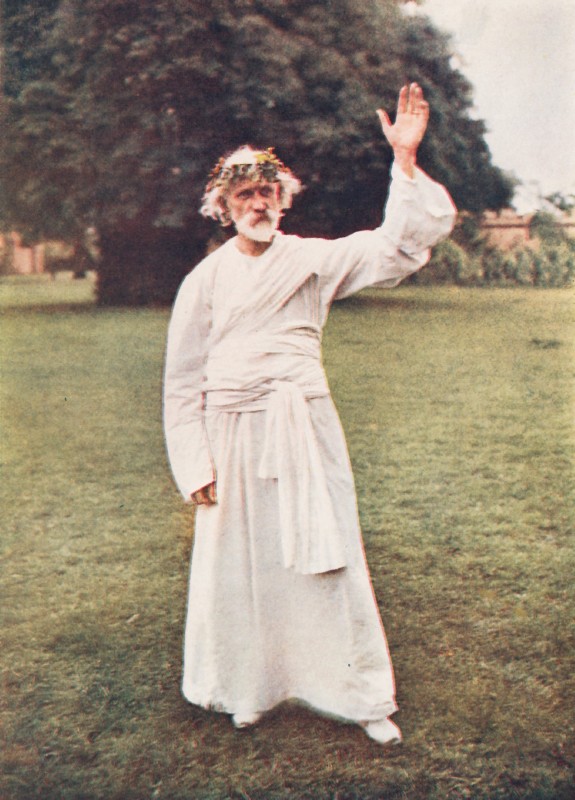CHAPTER
IX
THE
SACRED RIVER
IN our peeps at North
Wales we have more than once had a glimpse of the River Dee. To-day
we will pretend we have taken a "coracle," one of the
curious oval boats which were used in the very earliest days, and
which you may sometimes see a man carrying on his shoulders from one
bend of the river to another. "Carry thou me, and I will carry
thee," an old Welsh proverb makes the coracle say to the
fisherman; and it shall now carry us down the course of the river as
far as it lies within the land of Wales. The River Dee, one of the
most lovely in Wales, has always been connected with the mysterious
religion of the Druids. Its very name in old days, Deva, meant the
goddess, or the "divine one"; and its modern Welsh form,
Dwy, means the same thing. A legend of Druid times says that the Dee
springs from two fountains high up in the mountains above Bala,
called Dwy Fawr and Dwy Fach, or the Great and Little Dee, whose
waters pass through those of the Lake of Bala without mingling with
them, and come out at its northern extremity. These fountains
had their names from two individuals, Dwy Fawr and Dwy Fach, who
escaped from the Deluge when all the rest of the human race were
drowned, and the passing of the waters of the two fountains through
the lake without mingling with its flood is an emblem of the
salvation of the two individuals from the Deluge, of which the lake
is a type.

A DRUID PRIEST
Probably the river was
worshipped as a goddess in those days, and when Wales learnt the
Christian faith, it would be but fitting that her bank should be
crowded with those who sought baptism in her waters. Nowadays, too,
it is no uncommon sight to see a little group of people by the
waterside presiding over the baptism of one or more of their
companions.
Soon after leaving the
lake the Dee passes through a district that is closely connected with
the youth of that great Celtic hero, King Arthur. There are few parts
of Wales which—by their names, at least—allow us to forget that
Arthur and his Court played a famous part in Britain in the days
before history. And here we have Caer Gai, the ancient stronghold of
Sir Kay, the foster-brother of Arthur, who could make himself as tall
as the tallest tree in the forest, or lie hidden in lake or river for
nine days and nights, if needs be. Such fire was in his nature that
when they needed warmth his companions had but to kindle the piled
wood at his finger; he could walk through torrents of rain as dry as
on a summer's day; he could go for nine days and nights without
sleep; and no doctor could heal the wounds made by his sword.
It was in this district
of Penllyn, opposite to the hill of Yr Aran, which he calls "Rauran,"
that Spenser in his great poem makes King Arthur describe the
way his boyhood was passed in the "stronghold of Kay," or
Caer Gai:
"Whose dwelling is
low in a valley green
Under the fort of Rauran,
mossy hoar,
From whence the River
Dee, as silver clean,
His tumbling billows
rolls with gentle roar;
There all my days he
trained me up in virtuous lore."
But, apart from legend,
Caer Gai touches history itself. From its well-preserved
ramparts and "fosse," or moat, enclosing what is now a
farmhouse, we see that it must have once been a Roman, fortress.
Roman urns have been dug up here, arid not very many years ago a
ploughman turned up a stone with an inscription that showed it must
have been placed there by Roman soldiers about A.D. 105.
Leaving Llyn Tegid, or
Bala Lake, behind us, we set off down our river to Corwen and
Llangollen. These places we have already visited, so we will only
stay to notice the lovely scenery of this part of the Dee, so dear to
fishers. Not far from where the river bends north-east to Chester and
the sea, stands Chirk Castle, and near by, in order to reach it from
Llangollen, we shall pass the line of Offa's Dyke, a bank with a moat
below it that ran from the mouth of the Dee to the mouth of the Wye,
which was erected by a King of Mercia in the eighth century as a
barrier beyond which no Welshman might pass.
For the rest of its
course, therefore, the Dee really forms part of the boundary-line
between England and Wales, and though we shall be sorely tempted to
linger when we come to the beautiful old city of Chester, gazing down
from its ancient walls upon the broad river below, we must remind
ourselves that this is English soil, and leave the sacred waters of
the Dee to empty themselves by a very long estuary into the sea some
miles below Flint Castle, the last refuge of the unhappy Richard II.
before he gave himself into the hands of Bolingbroke.
|

